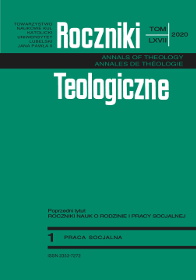Ukrainian Volunteers – New Generation of Social Workers. Problems and Perspectives
Abstrakt
Ukraińscy wolontariusze – nowe pokolenie pracowników socjalnych. Problemy i perspektywy
Działalność charytatywna w społeczeństwie ukraińskim, które jest w stanie wojny, zakłada zainteresowanie kwestią pracy wolontariuszy socjalnych. W dziedzinie psychologii i pracy socjalnej także nastąpiły poważne zmiany – pojawiła się pozytywna psychologia zdrowia i pozytywne nastawienie do pracy socjalnej. „Rewolucja emocjonalna” następuje w zakresie pracy zawodowej, prawidłowego funkcjonowania osobowości i dobrostanu jednostki. Takie inicjatywy i nastawienie legły u podstaw prezentowanych badań.
Próba badawcza obejmowała 100 ochotników ukraińskich grup paramilitarnych. Zbadane zostały powiązania pomiędzy stopniem wypalenia emocjonalnego, cechami osobowości należącymi do „ciemnej triady” a subiektywnym poczuciem zadowolenia i dobrostanem psychicznym.
Okazało się, że większość badanych osób znajduje się „w granicach normy” wypalenia emocjonalnego, ale tylko w jego pierwszej i drugiej fazie, tj. „napięcia” i „wyczerpania”. Stosunek liczby ochotników o dużym nasileniu pozytywnych cech osobowości i tych o niskim nasileniu cech negatywnych należących do „ciemnej triady” i na odwrót – tych o niskim poziomie cech pozytywnych i wysokim poziomie cech negatywnych, będących w trzeciej fazie wypalenia emocjonalnego – wynosi 1,5, tzn. 64 / 42%. Paradoksalnie, wykazano także odwrotną korelację pomiędzy wysokimi wynikami w zakresie „ciemnej triady” a niskim wypaleniem emocjonalnym oraz dodatnią korelację pomiędzy narcyzmem a poziomem subiektywnego poczucia zadowolenia. Jedyny element, który różnicuje dwie grupy ochotników, to najwyższe uzyskane wyniki w zakresie dobrostanu psychicznego oraz sumienność jako cecha osobowości (wielka piątka).
Dane te świadczą o większej podatności na negatywne konsekwencje wypalenia wśród „dobrych” ochotników o wysokim morale (niskie wyniki w zakresie „ciemnej triady”).
Uzyskane wyniki skłaniają badaczy do odpowiedzi na pytanie, czy aby być „najlepszym” ochotnikiem formacji paramilitarnej, nie trzeba mieć dobrego zdrowia, lecz być w stanie znacznego wypalenia emocjonalnego i zawodowego w warunkach wojny?
Bibliografia
Boyko, V.V. The energy of emotions in communication: a look at oneself and on others. Yaroslavl: Avers Press, 2004.
Caprara, G.V. “Positive orientation: Turning potential into optimal functioning.” The European Health Psychologist (2009), 11: 46–48.
Definition of BURNOUT [https://www.merriam-webster.com/dictionary/burnout] (accessed 22 June, 2019).
Deiner, E. International differences in well-being. N.Y.: Oxford University Press, 2010.
Dierendonck, D.V., Schaufeli, W.B., Siksma, H.J. “Burnout among general practitioners: a perspective from equity theory,” Journal of Social and Clinical Psychology (1994), 13 (1): 96–108.
Ekimova, S.G. Volonterskaia deiatel’nost” kak resurs lichnostno-professional’nogo razvitiia budushchikh spetsialistov po sotsial’noi rabote,”. Diss. kand. ped. nauk. [Volunteering as a resource for personal-professional development of the future of social work. PhD (pedagogy) diss.]. Khabarovsk, 2010.
Emotions at work: Theory, research and applications for management. Ed. R.L. Payne, C.L. Cooper. Chichester, UK: John Wiley and Sons, 2006.
Hulsheger, U.R., Lang, J.W., Maier, G.W. “Emotional labor, strain, and performance: Testing reciprocal relationships in a longitudinal panel study.” Journal of Occupational Health Psychology (2010), 15(4): 505–521.
Freudenberger, H.J. “Staff Burnout.” Journal of Social Issue (1974), 30 (1):159-65.
Fullugar, C., Kelloway, E.K. “New Directions in Positive Psychology: Implications for a Healthy Workplace.” In: Contemporary occupational health psychology: Global perspectives on research and practice. Ed. J. Houdmont, S. Leka, R.R. Sinclair (146–161). Chichester, UK: John Wiley & Sons, Ltd., 2012.
Jones, D.N., Paulus, D.L. “Introducing the Short Dark Triad (SDT): A Brief Measure of Dark Personality Traits.” Assessment (2014), 21(1): 28–41.
Korneeva, E.L. The main directions of research volunteer activities [Elektronnyi resurs]. Psikhologicheskaya nauka i obrazovanie PSYEDU.ru [Psychological Science and Education PSYEDU.ru], 2015, vol. 7, no. 1. Available at: http://psyedu.ru/journal/2015/n1/Korneeva.phtml (Accessed dd.mm.yyyy). (In Russ., Abstr. in Engl.).
Maslach, C. Burnout: The cost of caring. NY: Prentice-Hall, 1982.
Maslach, C., Leiter, M.P. “Understanding the burnout experience: Recent research and its implications for psychiatry.” World Psychiatry (2016), 15(2): 103-111.
Nosenko, E.L., Hrysenko, N.V. “Novyi pidhid do doslidjennya ‘tsinnostey u diyi: perevahy, dosvid, zastosuvannya dlya vyvchennya chynnykiv emotsiynoho vihorannya pedahoha,” Zbirnyk naukovykh prats KPNU imeni Ivana Ohiyenka. Problemy suchasnoyi psykhologiyi (2010), 10: 490–500.
Pines, A.M., Aronson, E., Kafry, D. Burnout. From Tedium to Personal Growth (345–356). NY: Free Press, 1981.
Paulhus, D.L., Williams, K.M. “The Dark Triad of personality: Narcissism, Machiavellianism and psychopath.” Journal of Research in Personality (2002), 36(6): 556–563.
Rawlins, T.D., Houska, А. “Motivations and satisfactions of the hospice of wichita volunteer: implications for marketing.” American Journal of Hospice and Palliative Care (1986), 3(4): 15–18.
Ryff, C. “The Structure of Psychological Well-Being Revisited.” Journal of Personality and Social Psychology (1995), 69(4): 719–727.
Seligman, M.E.P., Steen, T., Park, A.N., “Positive Psychology Progress. Empirical Validation of Interventions,” American Psychologist (2005), 2: 410–421.
Selye, H., Stress without distress. Moscow: Progress, 1998.
Seibert, L.A., Miller, J.D., Few, L.R., Zeichner, A., Lynam, D.R. “An Examination of the structure of self-report psychopathy measures and their relations with general traits and externalizing behaviors.” Personality Disorders: Theory, Research, and Treatment (2011), 2(3): 193–208.
Vodopyanova, N., Starchenkova, Y. Burnout syndrome: diagnosis and prevention. 2nd ed. SPb.: Peter, 2008.
Copyright (c) 2020 Roczniki Teologiczne

Utwór dostępny jest na licencji Creative Commons Uznanie autorstwa – Użycie niekomercyjne – Bez utworów zależnych 4.0 Międzynarodowe.





